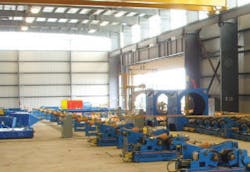Sustainable Pipe Mill Surpasses California Title 24 Lighting Requirements
United Spiral Pipe (USP), a Pittsburg, Calif.-based producer of large diameter double-submerged arc-welded (DSAW) pipe for the oil and gas industry, promotes four core corporate values: safety, quality, customer service, and environmental awareness. To help uphold its commitment to preserving the environment, the company recently constructed a spiral-wound manufacturing facility that is not only constructed to LEED standards, but also exceeds California's strict Title 24 lighting requirements.
“The USP pipe manufacturing facility utilizes a high-end lighting system that employs extensive daylighting,” notes Perry Kravec, an NCQLP certified electrical designer for CDMG, the Canonsburg, Pa.-headquartered firm that provided construction engineering, construction management, and scheduling services for the project.
According to Kravec, the approximately 350,000-sq-ft pipe mill features an abundant number of translucent panels installed within its exterior walls. Photocells mounted around the building's inside perimeter face the translucent panels and measure the amount of light entering the facility.
“These photocells send a signal to the facility's daylight controllers, which, in turn, interpret the signal and dispatch further information to a computer,” he explains. “The computer then reads this data and transmits it to the addressable breaker that controls the lights.”
Mike Slifko, CDMG's lead electrical engineer, says it's this addressable breaker technology that makes the project particularly distinctive.
“Mill lighting control typically is done with contactors and relays,” he remarks. “With the USP facility, we used breakers that are addressable via a low-voltage interface to any computer with Internet access. This means all the lighting circuits can be operated via any computer connected to the Internet.”
In addition, the lighting circuitry is arranged so that rows of lights can be shut off around the mill's indoor perimeter.
“We estimate 25% of the lights can be shut off during a sunny day,” observes Kravec. “After commissioning is complete, we expect even more lights will be extinguished.”
To achieve further energy savings, CDMG put considerable effort into selecting the proper lamps and controls. Using T5 high-output (T5HO) fluorescent luminaires, the company says it optimized the lighting system at 32% below California Title 24 requirements for watts per square foot.
“We found that, for this application, the high-bay luminaire we used was 18% more efficient than its closest competitor,” Kravec states. “This allowed us to use a symmetrical layout of three rows with one double fixture per column. The plant's lighting consumes just 0.75W per square foot to achieve a maintained 52-fc light level.”
Further benefits of the T5HO include a long life, reduced maintenance, and a uniform lighting level.
A reflective roof to reduce heat transmission adds to the building's energy efficiency. Completed on schedule, the USP facility is expected to create 120 new full-time manufacturing jobs. In addition, the pipe-making and coating facility is capable of producing 300,000 net tons of API specification line pipe per year.
“I would also like to note that this was a ‘greenfield’ project, meaning it was constructed from the ground up as opposed to a remodel or retrofit,” adds Slifko. “The stringent California Title 24 requirements afforded CDMG a unique opportunity to demonstrate our expertise and incorporate state-of-the-art lighting technology, which, in the longrun, will significantly reduce energy usage.”
About the Author
Stefanie Kure
Content Producer - EC&M
Stefanie Kure is the senior associate editor of EC&M magazine. She holds a Bachelor of Arts degree from the University of Kansas and has more than 20 years of experience in the B2B magazine industry. In addition to EC&M, Stefanie has worked on Transmission & Distribution World magazine, Broadcast Engineering magazine, and Power Electronics Technology magazine.
